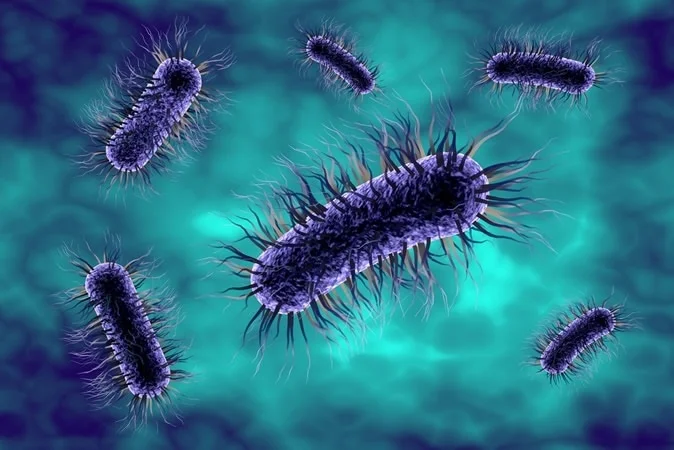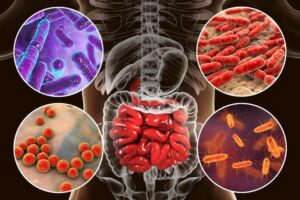In 1900, the three leading causes of death were: pneumonia (viral or bacterial), tuberculosis (bacterial), and diarrhea and enteritis (bacteria or viral). Children under 5 years of age accounted for 40% of the total deaths caused by the aforementioned illnesses. By this time, bacterial infections had already wiped out millions of people. Simple cuts could cause blood poisoning, and there was nothing doctors could do about it. It was a scary time to be alive, indeed!
Then, in 1943, a miracle drug was developed. Penicillin! This drug was the first of its kind (an antibiotic) and saved countless lives. Soon, more and more classes of antibiotics were being developed. To this day, the discovery of penicillin is considered one of the most significant medical advances in history, having saved millions of lives. No longer did man have to fear death from simple bacterial infections. It was a great time for all.
Soon enough, however, bacteria became wise to our drugs. By 1947, just four years after the discovery of penicillin, there was already a bacterium that had developed resistance to penicillin, most likely because penicillin was so widely prescribed—it was available without prescriptions. Even Alexander Fleming, the discoverer of penicillin, warned that overuse would create “mutant forms” of bacteria that could cause more serious infections (1).
Amount of antibiotics prescribed per year
Between 2000 and 2010, about 1.4 billion outpatient antibiotics were prescribed in the US (2). This came out to be about 104 million antibiotics prescribed per year (2). This does not take into account the large amounts of antibiotics given in hospitals every day. The CDC reported that 4 out of 5 Americans are prescribed antibiotics each year.
Why do we need bacteria?
Antibiotics are indiscriminate killers of bacteria. We have trillions of bacteria in our bodies. They inhabit nearly all areas of our body, including our mouth, skin, and gut (3). Most of them are good. They help us digest plant starch; they help renew the walls of our digestive tract; they supply essential nutrients; and they help protect against the development of harmful bacteria (3). They also have roles in maintaining our immune system.
Some of the bacteria promote inflammation, and some reduce inflammation. It depends on our bacterial makeup. Some bacteria in us are opportunistic, and when our immune system is compromised (as in AIDS), these normally harmless bacteria turn deadly. The point is that we need good bacteria in our bodies. Killing off good bacteria leaves our body open to colonization by harmful bacteria.
What causes resistance?
The amount of antibiotics used and how they are used influence the development of antibiotic-resistant bacteria (4). Antibiotics that target a broad range of bacteria (compared to antibiotics targeting specific, non-general bacteria) increase the chance of creating resistant bacteria (4). Often, doctors prescribe antibiotics for viral infections, for which they are useless (4). Sometimes doctors prescribe the wrong doses of antibiotics for bacterial infections or prescribe antibiotics for incorrect periods of time, both contributing to antibiotic resistance (4).
Many times, antibiotics are prescribed for colds, sore throats, and other viral infections for which antibiotics do not work. 50 million courses are prescribed for viral respiratory infections and 18 million courses are prescribed for colds each year, according to the CDC. A majority of the antibiotics prescribed per year are for children. Although decreasing, 229 antibiotic courses per 1,000 doctor office visits were prescribed to children less than 14 years old in 2007–2008 (5).
It seems that long-term incorrect dosages of antibiotics produce more resistant bacteria than short-term high doses of antibiotics (4). Human use of antibiotics makes up 50% of total antibiotic consumption in the US and the European Union (farm animals use very high amounts too) (4). Until about 10–20 years ago, most antibiotic-resistant bacteria were seen in hospitals due to the heavy use of antibiotics administered (4). There is much resistance outside of hospitals today, as community doctors prescribe antibiotics very often in outpatient settings (4).
As many antibiotics are structurally similar, taking one antibiotic may cause the development of bacteria that are resistant to multiple antibiotics. So even if one antibiotic is stopped and another begins, if they are similar enough, bacteria will become resistant to both antibiotics. One of the most worrisome-resistant bacteria is E. faecium. This bacteria is resistant to so many antibiotics (even new ones) that there is no antibiotic drug approved by the FDA for use against it (6).
Examples of resistance
A few examples of antibiotic use that may have spawned antibiotic-resistant bacteria are as follows: In Finland, there was a strong link between the increased use of erythromycin (an antibiotic) and an increase in erythromycin-resistant bacteria seen in groups in the early 1990s (4). In Iceland, antimicrobial use was strongly associated with penicillin-resistant bacteria in children (4).
An example of how quickly bacteria can develop resistance can be seen in the use of erythromycin (an antibiotic alternative to penicillin), which was used in a Boston hospital and completely discontinued less than a year later because 70% of the bacteria it was used against became resistant to it (7). Bacteria are able to transfer their drug resistance to other bacteria in our colon.
Dangers of antibiotic resistance (what can happen)
Every year in the United States, there are at least 2 million cases where people have resistant bacteria, and at least 23,000 people die each year because of our inability to deal with these antibiotic-resistant bacteria (8). Many of the medical marvels of today, such as organ transplants, joint replacements, and cancer therapy, rely on the ability of antibiotics to kill any bacterial infection resulting from these operations (9).
If we are unable to combat infections resulting from these types of operations, the risk of death following the operation will outweigh any benefit the operation offers. Many surgeries, such as open heart surgery, put the patient at increased risk for surgical site infection, which may rely on antibiotics to cure. People with cancer who receive chemotherapy have a lowered white blood cell count (these fight infections), so any infection can be potentially life-threatening, and quick use of antibiotics is paramount.
Since antibiotics kill all bacteria indiscriminately (even healthy bacteria we need), giving children needless antibiotics can destroy the normal healthy bacteria in their digestive system that they need for proper immune function. A study found that children who took antibiotics often when they were young were at an increased risk of developing asthma later on (10).
A theory from scientists that has not pan out is that over time, bacteria that develop resistance to a drug will disappear. Once the drug is stopped for a long period, the resistant bacteria will disappear as there is no longer selective pressure on the resistant bacteria (since the drug is not being used). Unfortunately, this does not appear to be true (4). High levels of antibiotic-resistant bacteria in humans and animals have been found even when antibiotic use was stopped for a long period of time (4).
How to reverse the spread of resistant bacteria
It may be hard to reverse antibiotic resistance simply by reducing the amounts prescribed. Bacteria have developed a way to stabilize their resistant genes (4). Bacteria have developed resistance hand in hand with the increased number, volume, and diversity of antibiotic classes prescribed to humans over the past few decades (4). As we developed and administered new antibiotics soon after, we found bacteria in humans that were resistant to the new antibiotics (4).
One step that would help reverse resistance is the administration of antibiotics that target a narrow spectrum of bacteria and less broad-spectrum antibiotics, which have been shown to produce more resistant bacteria than their narrow-spectrum counterparts. It appears that the reversal of antibiotic-resistant bacteria is much slower than the development of antibiotic-resistant bacteria, and even after control and decreased use of antibiotics, the levels of resistant bacteria decrease but do not reach the low levels seen before the use of antibiotics.
Doctors must only be allowed to prescribe antibiotics for certain conditions. They must stop giving antibiotics for viruses just because the patient asks for some. Doctors must give the proper dosage so that all of the bacteria are killed, and people must take the whole prescription and not stop when they feel better.
Discussion
It is obvious that antibiotic-resistant bacteria are potential health disasters if we keep using antibiotics incorrectly. Bacteria have been shown to have an amazing ability to adapt to and evolve resistance to drugs. They evolve more rapidly than we can create new drugs. We do not have an endless supply of antibiotic drugs, and the pace of discovering ones has slowed recently.
We do not want to return to the dark ages where people died from simple bacterial infections. Thousands of people already die each year because of resistant bacteria that we have no way to fight. When bacteria become resistant, we are forced to try more and more different types of antibiotics, which are very expensive and increase the risk of side effects from all the different drugs.
We should take steps to protect ourselves from developing antibiotic-resistant bacteria. Parents should not let their children receive antibiotics for a cold or any other illness likely to be a virus. If you get sick, try to let the illness go away on its own, as it naturally would. If you must get antibiotics, make sure you use the whole prescription. Stopping too soon can let the bacteria with resistance to the drug inhabit the colon and multiply.
Sources
- Alanis, A. J. (2005). Resistance to antibiotics: are we in the post-antibiotic era?. Archives of medical research, 36(6), 697-705.
- Lee, G. C., Reveles, K. R., Attridge, R. T., Lawson, K. A., Mansi, I. A., Lewis, J. S., & Frei, C. R. (2014). Outpatient antibiotic prescribing in the United States: 2000 to 2010. BMC medicine, 12(1), 96.
- Round, J. L., & Mazmanian, S. K. (2009). The gut microbiota shapes intestinal immune responses during health and disease. Nature Reviews Immunology, 9(5), 313-323.
- Barbosa, T. M., & Levy, S. B. (2000). The impact of antibiotic use on resistance development and persistence. Drug resistance updates, 3(5), 303-311.
- http://www.cdc.gov/mmwr/preview/mmwrhtml/mm6034a1.htm
- Arias, C. A., & Murray, B. E. (2009). Antibiotic-resistant bugs in the 21st century—a clinical super-challenge. New England Journal of Medicine, 360(5), 439-443.
- Davies, J., & Davies, D. (2010). Origins and evolution of antibiotic resistance. Microbiology and Molecular Biology Reviews, 74(3), 417-433.
- http://www.cdc.gov/features/antibioticresistancethreats/).
- http://www.cdc.gov/media/releases/2013/p0916-untreatable.html).
- Kozyrskyj, A. L., Ernst, P., & Becker, A. B. (2007). Increased risk of childhood asthma from antibiotic use in early life. CHEST Journal, 131(6), 1753-1759.





Hi, my name is Andres, i’m a physician, i wanted to say congratulations on this article, this is currently a big concern for physicians nowadays. You mentioned that one of the causes was the prescription of antibiotics (AB) to patients with probable viral pathogens. I just wanted to add that there are numerous factors playing in this increasing number of mutating bacteria.
1. Patient treatment compliance: the patient needs to complete the whole treatments as prescribed, to avoid low serum concentrations that don’t kill the bacteria, and avoiding its exposure for it to mutate to a stronger strain.
2. Patient follow up: this is crucial, the patients that are prescribed antibiotics have to get a follow up. What for? it is general recommendation that if a bacterial infection is suspected, a sample is needed to cultivate, therefore confirming the exact type of bacteria, its AB sensitivity ( identifies what AB kills it), and when the culture is negative, it rules out the necessity of AB treatment. This usually takes 3-7 days
3. Antibiotics: storing conditions, product quality (pharmaceutical company) , adequate dosage (there are some medications that come in many presentations, pay attention and buy the exact one in the prescription) , availability (in some places the ideal antibiotic for the infection is not immediately available), expiry date (always look for it).
4. Allergies: this forces the physician to prescribe second line medications, which usually are more expensive and powerful than the first choice. It also limits options in choosing the ideal AB.
5. Other illnesses: Diabetes, Kidney Failure, Cirrhosis, etc. These medical conditions limit the dosage and the type of AB prescribed, it has a direct effect because it usually ties our hands to using only certain AB, and not the ideal ones.
These are just some of the factors at play in the mutation of bacteria. Currently there is a huge concern regarding Staphylococcus aureus infections (AKA Staph infections), because of its alarming mutation rate and lack of AB response. This bacteria is one of the most common causes of surgical site infection.
Awareness should be raised of this increasing problem and its solutions. Which you are doing very well in this article, it’s easy to read, entertaining and clear. Thank you and best wishes on your site!!
Hey Andres thanks for reading and commenting! It is great having a doctors view on this topic. I think having the patients come in to verify that they have a bacterial and not viral infection should be common practice everywhere. This would save prescribing tens of thousands of people antibiotics a year when they do not need them. Patient compliance is probably the biggest factor in preventing antibiotic resistance and unfortunately this is the factor doctors have least control over.
You mentioned having to take patient allergies into consideration which I did not go over in my write up. I agree that having to prescribe alternative, more powerful and more expensive antibiotics when people have allergies can cause even more reactions and limits the choices doctors have. A huge problem you discussed was being limited to prescribe antibiotics in people with severe diseases. This is unfortunate as these people may have compromised immune systems and rely on antibiotics to combat any opportunistic infection.
You definitely helped expand on what i discussed and brought up many important new issues that I could not adequately cover in my blog due to length restrictions (I would write 10 page blogs but I doubt people would read them). I found your comment very insightful and look forward to hearing your thoughts on future topics!
This article is very interesting and scary… Terrifying how bacteria can be immune to their antibiotics; mutating and becoming stronger.
I really enjoyed reading this article and really enjoyed Dr. Cobar’s input as a doctor.
I want to share another story with you. When I was a teenager, I was cooking (my cooking skills were not that great). I remember preparing pees with mushrooms sauce. At one point in the recipe, I was cutting butter and I deep cut my middle finger. (YES, wounding my finger cutting a piece of butter – how great my cooking skills were back then. In my defense, it was frozen.) So my parents took me to the hospital and I have to have 1 stitch and a tetanus shot just in case.
A long time ago, people used to die by the tetanus disease when they used to get cut from a fence in the field or many other similar situations. But thanks to science now you can have peace of mind knowing you have your tetanus vaccine. (I know you have to have your booster shot every 10 years) This makes you prepared if you decide you want to cook something fancier than just cutting butter LOL.
Ouch. Should have used a butter knife! Yes science has come a long way over the past century. We have erradicted many contagious diseases. Antibiotics are one of the most important scientific discoveries ever at least in regard to saving human lives. Unfortunately overuse has led us to where we are today…dying from bacterial infections that we already had a cure for decades ago. Fortunately not many people die each year because of this but if we do not change our practices a few decades down the line that number may increase greatly.
http://www.ted.com/talks/kary_mullis_next_gen_cure_for_killer_infections
THIS is thinking out of the box! hopefully we will have this soon enough